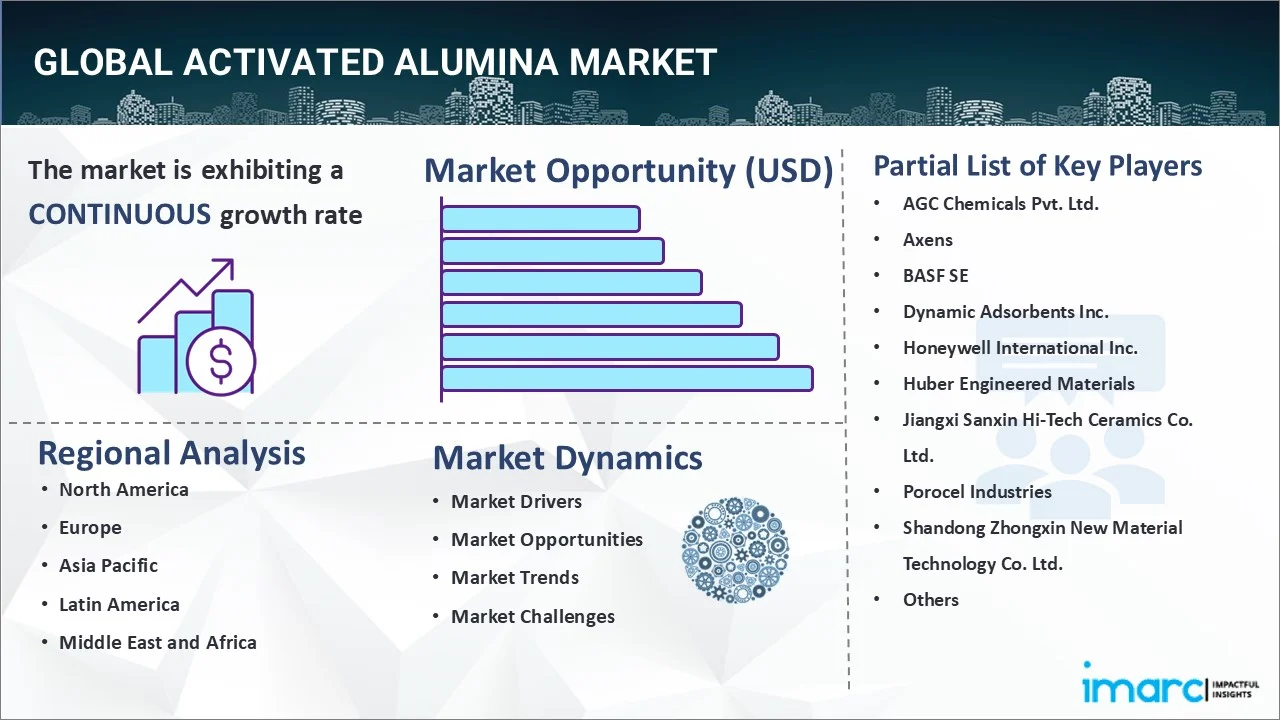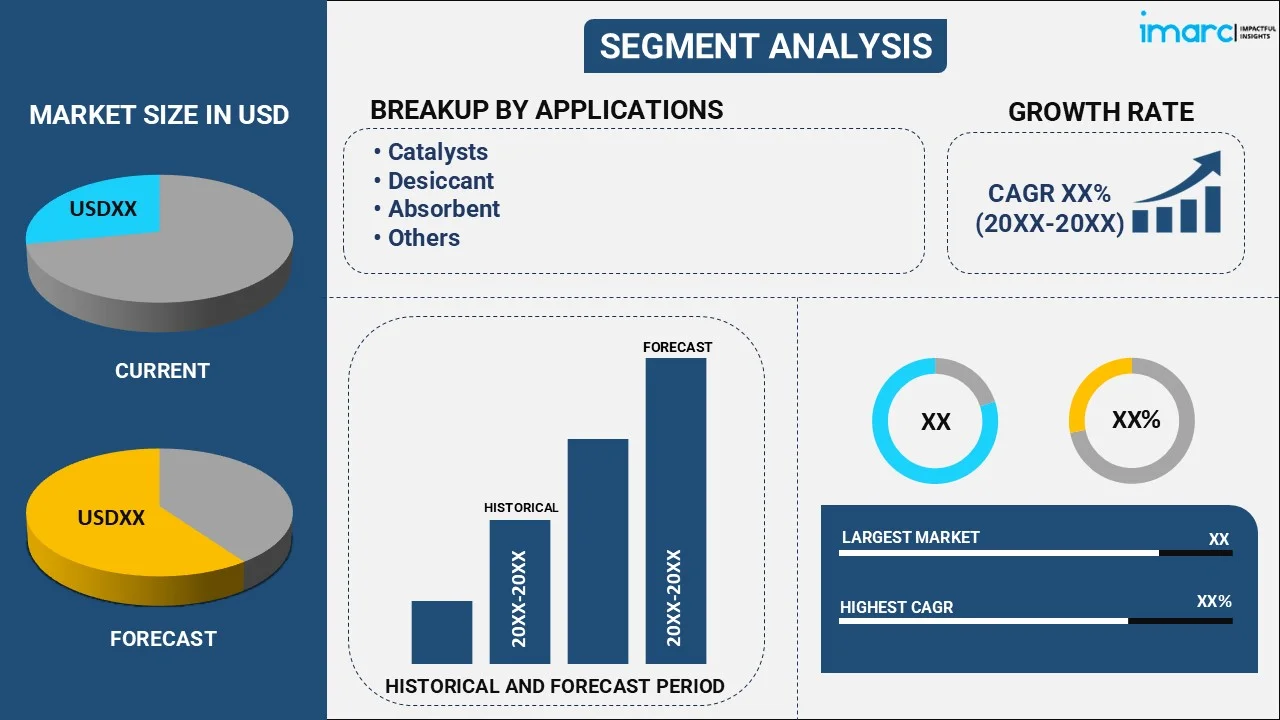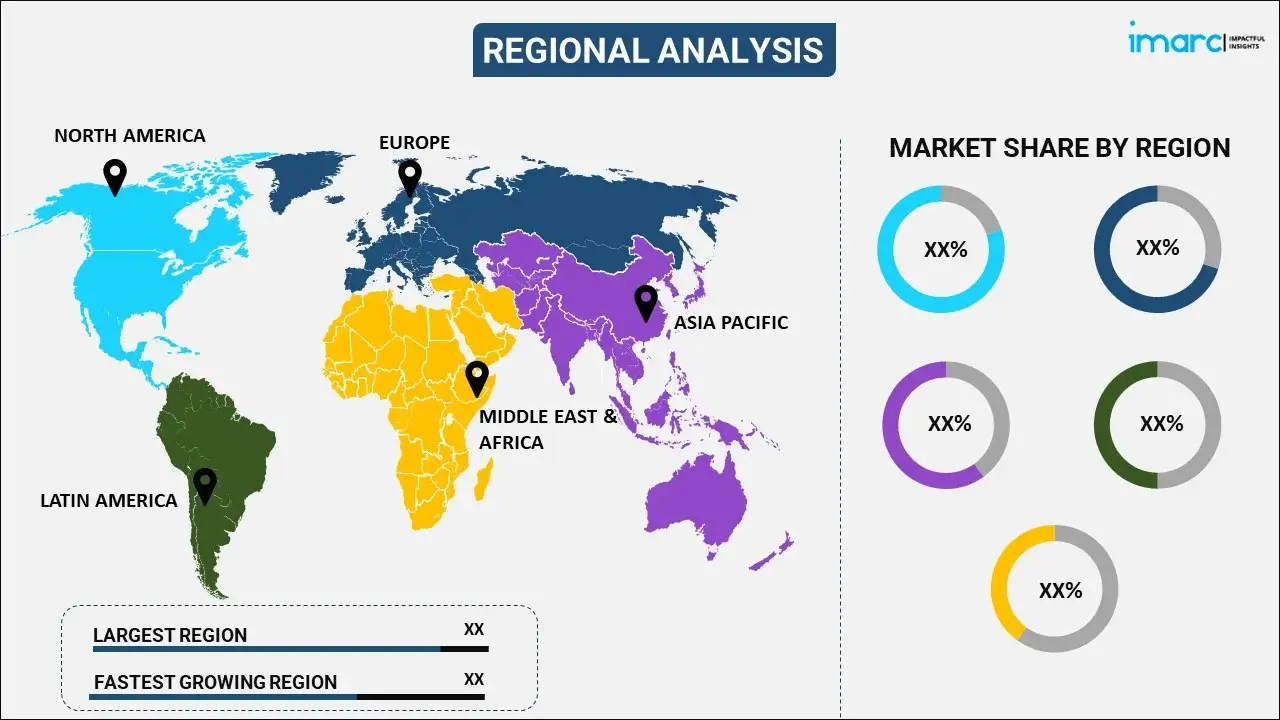
Activated Alumina Market Report by Application (Catalysts, Desiccant, Absorbent, and Others), End-Use Industry (Water Treatment, Pharmaceutical, Textile, Oil & Gas, Chemical, and Others), Form (Powder, Beads), Mesh Size (80-150 Mesh, 150-300 Mesh, Above 300 Mesh), and Region 2025-2033
Activated Alumina Market Size:
The global activated alumina market size reached USD 1,100.4 million in 2024. Looking forward, IMARC Group expects the market to reach USD 1,625.9 million by 2033, exhibiting a growth rate (CAGR) of 3.98% during 2025-2033. The increasing water purification needs, demand for purified gases, versatility in chemical processes, adaptability as an absorbent, and suitability for specialized applications such as chromatography, are some of the major factors propelling the market. In 2024, Asia Pacific captured the largest market share, contributing to 41.6% of the total.
|
Report Attribute
|
Key Statistics
|
|---|---|
|
Base Year
|
2024
|
|
Forecast Years
|
2025-2033
|
|
Historical Years
|
2019-2024
|
| Market Size in 2024 | USD 1,100.4 million |
| Market Forecast in 2033 | USD 1,625.9 million |
| Market Growth Rate 2025-2033 | 3.98% |
Activated Alumina Market Analysis:
- Market Growth and Size: The market is expanding at a significant pace with the development of its application toward water treatment and desiccation. Research reports suggest a steady increase in market size, propelled by rising demand in industrial and consumer sectors.
- Major Market Drivers: The primary market driver for activated alumina is the escalating need for purified water in various industries, which is reflected in recent price trends. Additionally, its effectiveness in catalyst applications has been stated in numerous research reports, further stimulating market expansion.
- Key Market Trends: The major trend identified in the market is a rise in the utilization of activated alumina for the removal of fluoride from water, which factors have been consistently highlighted in research reports. Also, changing price trends and visible shifts toward means for cost-efficient production and offering product innovative offerings.
- Geographical Trends: According to many research reports, the leading demand in the Asia-Pacific region is being witnessed by rapid industrialization and issues of water scarcity. In North America and Europe, on the other hand, such growth is steady and influenced by stringent environmental regulations with subsequent adaptations in price trends.
- Competitive Landscape: High consolidation characterizes the competitive landscape, where major market players are focusing on enlarging the product portfolio—a strategy dealt with, very commonly, by industry research reports. The pricing trends within this competitive frame show a strategic alignment with market demand aspects and regulatory standards.
- Challenges and Opportunities: Steady prices of raw materials are a big challenge since they largely impact the general price trends of activated alumina. The power sector also holds huge opportunities, more precisely in innovation and expanding applications, as stated in various research reports, promoting a landscape ripe for strategic investments and market growth.

Activated alumina is a porous and highly adsorbent material derived from aluminum oxide. It is produced through a controlled process that creates a large surface area with numerous microscopic pores. This unique structure gives activated alumina exceptional adsorption capabilities, making it widely used for purification, dehydration, and filtration applications in various industries. It effectively removes contaminants such as moisture, volatile organic compounds (VOCs), and impurities from liquids and gases. Besides this, activated alumina finds extensive use in drying processes, gas refining, water treatment, and catalyst support due to its high surface area and tailored surface properties that enable targeted interactions with specific molecules.
The rising need for water purification solutions in both municipal and industrial sectors has led to heightened adoption of activated alumina due to its exceptional adsorption properties, effectively removing contaminants such as fluoride, arsenic, and other impurities from water sources. This represents the key factor impelling the growth of the global activated alumina market. Furthermore, the expanding demand for clean and safe gases in industries, such as petrochemicals, healthcare, and electronics, is propelling the market forward as activated alumina is utilized for drying and purifying gases. Moreover, widespread product application as catalyst support in various chemical processes is aiding in market expansion. Additionally, the surge in manufacturing activities and infrastructure development in emerging economies is boosting the demand for activated alumina in applications such as chromatography, which, in turn, is creating a positive outlook for market growth. Apart from this, the increasing environmental regulations and a focus on sustainable solutions are fueling the adoption of activated alumina.
Activated Alumina Market Trends/Drivers:
Water purification and treatment needs
One of the key drivers of the activated alumina market is the escalating demand for effective water purification solutions. As concerns over water quality and safety intensify, the use of activated alumina as an adsorbent material in municipal water supplies and various industrial processes has gained prominence, strengthening the market growth. In addition to this, activated alumina's ability to efficiently remove contaminants such as fluoride, arsenic, and heavy metals from water sources has made it a preferred choice for water treatment applications. This factor is particularly critical in regions grappling with high levels of naturally occurring or anthropogenic pollutants in their water systems.
Gas drying and purification requirements
The increasing need for high-purity gases in various industries is acting as another growth-inducing factor. Numerous industrial verticals, such as petrochemicals, electronics manufacturing, pharmaceuticals, and healthcare, rely on purified gases to ensure product quality and process efficiency. Activated alumina’s excellent adsorption properties make it an ideal choice for removing moisture and other impurities from gases, contributing to the overall reliability and effectiveness of gas-related processes. This demand for purified gases is spurred by the escalating need to meet stringent quality standards and regulatory requirements.
Catalyst support and chemical processes
The versatility of activated alumina extends to its application as catalyst support in numerous chemical processes. Catalysts play a pivotal role in facilitating and accelerating chemical reactions and activated alumina’s high surface area and tailored surface properties make it a valuable substrate for catalyst deposition. Industries such as petrochemicals, refining, and speciality chemicals benefit from the use of activated alumina as catalyst support to enhance process efficiency, product yield, and selectivity. The continued growth of these industries, coupled with the ongoing demand for optimized chemical processes, further contributes to the expansion of the activated alumina market.
Activated Alumina Industry Segmentation:
IMARC Group provides an analysis of the key trends in each segment of the global activated alumina market report, along with forecasts at the global, regional and country levels for 2025-2033. Our report has categorized the market based on application, end-use industry, form, and mesh size.
Breakup by Application:

- Catalysts
- Desiccant
- Absorbent
- Others
Absorbent dominates the market
In 2024, Absorbent established itself as the market leader with a share of 34.5%. The report has provided a detailed breakup and analysis of the market based on the application. This includes catalysts, desiccant, absorbent, and others. According to the report, absorbent represented the largest segment.
The increasing use of activated alumina as an absorbent due to its compatibility with various substances and precise adsorption through tailored surface modifications is creating a positive outlook for market expansion. Moreover, its application as an absorbent extends to diverse sectors, such as air separation units, natural gas processing, and the removal of volatile organic compounds (VOCs) from industrial emissions. This adaptability, coupled with its ability to maintain performance in harsh operating conditions, is fueling the demand for activated alumina's as a versatile and effective absorbent material across various specialized applications.
Breakup by End-Use Industry:
- Water Treatment
- Pharmaceutical
- Textile
- Oil & Gas
- Chemical
- Others
Water treatment holds the largest share in the market
With a market share of 33.2% in 2024, water treatment emerged as the leading end use industry. The demand for activated alumina in water treatment applications is driven by its extensive use in removing impurities such as fluoride, arsenic, and selenium from water. Due to its high adsorption capacity and chemical stability, active alumina finds application in the municipal and industrial water treatment systems.
According to the United Nations-Water’s Progress on Wastewater Treatment – 2024 Update, in 2022 nearly half of the household wastewater (42%) was released into the environment with inadequate or no treatment. Thus, growing awareness of the water quality, enhanced legal requirements for water treatment, and the need for clean drinking water have also influenced the development of this segment. Further, the increasing use of desalination technologies in the water deficit regions also contributes to the growth of the demand. While governments and industries continue to fund and develop effective water management strategies, the dependency on active alumina for water purification is expected to remain high.
Breakup by Form:
- Powder
- Beads
Beads dominate the market
In 2024, Beads captured the largest market share, contributing to 57.5% of the total.The report has provided a detailed breakup and analysis of the market based on the form. This includes powder and beads. According to the report, beads represented the largest segment.
The growing demand for activated alumina beads due to their suitability for specialized applications, such as chromatography, is acting as a significant growth-inducing factor. These beads offer a large surface area and controlled pore structure, making them ideal for selective adsorption and separation of compounds in analytical and purification processes. Concurrent with this, their adaptability to fine-tuning and customization in chromatographic applications, combined with their stability and consistent performance, is propelling their adoption in various industries, including pharmaceuticals, biotechnology, and environmental monitoring.
Breakup by Mesh Size:
- 80-150 Mesh
- 150-300 Mesh
- Above 300 Mesh
A detailed breakup and analysis of the market based on the mesh size has also been provided in the report. This includes 80-150, 150-300, and above 300 mesh.
The growing demand for activated alumina mesh in air drying applications is positively impacting the market growth. The diverse mesh sizes cater to specific moisture removal needs across industries such as compressed air systems, electronics manufacturing, and pharmaceuticals. The mesh structure ensures a balanced combination of surface area and airflow, enabling efficient moisture adsorption while minimizing pressure drop. As industries prioritize moisture control to prevent corrosion, equipment damage, and product contamination, the versatility of activated alumina mesh in addressing varying drying requirements is a key factor driving its demand.
Breakup by Region:

- North America
- United States
- Canada
- Asia Pacific
- China
- Japan
- India
- South Korea
- Australia
- Indonesia
- Others
- Europe
- Germany
- France
- United Kingdom
- Italy
- Spain
- Russia
- Others
- Latin America
- Brazil
- Mexico
- Others
- Middle East and Africa
Asia Pacific exhibits a clear dominance, accounting for the largest activated alumina market share
The market in 2024 was led by Asia Pacific, which held an estimated 41.6% share. The report has also provided a comprehensive analysis of all the major regional markets, which include North America (the United States and Canada); Asia Pacific (China, Japan, India, South Korea, Australia, Indonesia, and others); Europe (Germany, France, the United Kingdom, Italy, Spain, Russia, and others); Latin America (Brazil, Mexico, and others); and the Middle East and Africa. According to the report, Asia Pacific accounted for the largest market share.
Rapid industrialization and urbanization across the Asia Pacific region are driving the demand for clean water and purified gases, creating a significant need for effective water treatment and gas drying solutions. Besides this, the region's burgeoning manufacturing sector, particularly in electronics and petrochemicals, requires high-purity gases for production processes, thus bolstering the demand for activated alumina's adsorption capabilities. Additionally, stringent environmental regulations in countries like China and India are pushing industries to adopt advanced technologies for pollution control and waste reduction, which, in turn, is accentuating the demand for activated alumina in applications such as emissions control. As the Asia Pacific region continues its economic expansion and infrastructure development, the activated alumina market is witnessing robust expansion.
Competitive Landscape:
The competitive landscape of the global activated alumina market is characterized by the presence of several established manufacturers and suppliers striving to capture market share through innovation, strategic collaborations, and product differentiation. Companies are focusing on developing advanced activated alumina products with enhanced adsorption capabilities tailored for specific applications across industries such as water treatment, gas purification, and catalysis. Key players are also investing in research and development (R&D) to optimize production processes and improve the overall performance of their offerings. Market participants are increasingly emphasizing sustainable practices, integrating eco-friendly production methods and materials into their processes to meet the rising need for ecologically responsible solutions. Geographical expansion and distribution networks are pivotal strategies, allowing companies to penetrate emerging markets and cater to diverse customer needs.
The report has provided a comprehensive analysis of the competitive landscape in the market. Detailed profiles of all major companies have also been provided. Some of the key players in the market include:
- AGC Chemicals Pvt. Ltd.
- Axens
- BASF SE
- Dynamic Adsorbents Inc.
- Honeywell International Inc.
- Huber Engineered Materials
- Jiangxi Sanxin Hi-Tech Ceramics Co. Ltd.
- Porocel Industries
- Shandong Zhongxin New Material Technology Co. Ltd.
- Sialca Industries
- Sorbead India
- Sumitomo Chemical Co. Ltd.
Recent Developments:
- In October 2023, Axens announced Asset Sale Agreement (ASA) with Rio Tinto Alcan of Canada, acquiring their activated alumina business in Brockville, Ontario.
- In September 2020, BASF SE introduced a range of novel selective hydrogenation catalysts, including palladium alumina catalysts designed to exhibit strong resistance against sulfur impurities.
Activated Alumina Market Report Scope:
| Report Features | Details |
|---|---|
| Base Year of the Analysis | 2024 |
| Historical Period | 2019-2024 |
| Forecast Period | 2025-2033 |
| Units | Million USD |
| Scope of the Report | Exploration of Historical and Forecast Trends, Industry Catalysts and Challenges, Segment-Wise Historical and Predictive Market Assessment:
|
| Applications Covered | Catalysts, Desiccant, Absorbent, Others |
| End-Use Industries Covered | Water Treatment, Pharmaceutical, Textile, Oil & Gas, Chemical, Others |
| Forms Covered | Powder, Beads |
| Mesh Sizes Covered | 80-150 Mesh, 150-300 Mesh, Above 300 Mesh |
| Regions Covered | Asia Pacific, Europe, North America, Latin America, Middle East and Africa |
| Countries Covered | United States, Canada, Germany, France, United Kingdom, Italy, Spain, Russia, China, Japan, India, South Korea, Australia, Indonesia, Brazil, Mexico |
| Companies Covered | AGC Chemicals Pvt. Ltd., Axens, BASF SE, Dynamic Adsorbents Inc., Honeywell International Inc., Huber Engineered Materials, Jiangxi Sanxin Hi-Tech Ceramics Co. Ltd., Porocel Industries, Shandong Zhongxin New Material Technology Co. Ltd., Sialca Industries, Sorbead India, Sumitomo Chemical Co. Ltd., etc. |
| Customization Scope | 10% Free Customization |
| Post-Sale Analyst Support | 10-12 Weeks |
| Delivery Format | PDF and Excel through Email (We can also provide the editable version of the report in PPT/Word format on special request) |
Key Benefits for Stakeholders:
- IMARC’s report offers a comprehensive quantitative analysis of various market segments, historical and current market trends, market forecasts, and dynamics of the activated alumina market from 2019-2033.
- The research study provides the latest information on the market drivers, challenges, and opportunities in the global activated alumina market.
- The study maps the leading, as well as the fastest-growing, regional markets. It further enables stakeholders to identify the key country-level markets within each region.
- Porter's five forces analysis assist stakeholders in assessing the impact of new entrants, competitive rivalry, supplier power, buyer power, and the threat of substitution. It helps stakeholders to analyze the level of competition within the activated alumina industry and its attractiveness.
- Competitive landscape allows stakeholders to understand their competitive environment and provides an insight into the current positions of key players in the market.
Key Questions Answered in This Report
The global activated alumina market was valued at USD 1,100.4 million in 2024.
We expect the global activated alumina market to exhibit a CAGR of 3.98% during 2025-2033.
The rising utilization of activated alumina in drying processes, gas refining, water treatment, and catalyst support, owing to its high surface area and tailored surface properties that enable targeted interactions with specific molecules, is primarily driving the global activated alumina market.
The sudden outbreak of the COVID-19 pandemic had led to the implementation of stringent lockdown regulations across several nations, resulting in the temporary closure of numerous end-use industries for activated alumina.
Based on the application, the global activated alumina market can be segmented into catalysts, desiccant, absorbent, and others. Currently, absorbent holds the largest market share.
Based on the end-use industry, the global activated alumina market has been divided into water treatment, pharmaceutical, textile, oil & gas, chemical, and others. Among these, oil & gas currently exhibits a clear dominance in the market.
Based on the form, the global activated alumina market can be categorized into powder and beads. Currently, beads account for the majority of the global market share.
On a regional level, the market has been classified into North America, Asia Pacific, Europe, Latin America, and Middle East and Africa, where Asia Pacific currently dominates the global market.
Some of the major players in the global activated alumina market include AGC Chemicals Pvt. Ltd., Axens, BASF SE, Dynamic Adsorbents Inc., Honeywell International Inc., Huber Engineered Materials, Jiangxi Sanxin Hi-Tech Ceramics Co. Ltd., Porocel Industries, Shandong Zhongxin New Material Technology Co. Ltd., Sialca Industries, Sorbead India, Sumitomo Chemical Co. Ltd., etc.
Need more help?
- Speak to our experienced analysts for insights on the current market scenarios.
- Include additional segments and countries to customize the report as per your requirement.
- Gain an unparalleled competitive advantage in your domain by understanding how to utilize the report and positively impacting your operations and revenue.
- For further assistance, please connect with our analysts.
 Inquire Before Buying
Inquire Before Buying
 Speak to an Analyst
Speak to an Analyst
 Request Brochure
Request Brochure
 Request Customization
Request Customization




.webp)




.webp)












